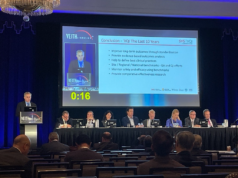
Following the publication of “Another nail in the coffin of vena cava filters” in the British Journal of Surgery, which considered potential problems with the use of inferior vena cava (IVC) filters, authors Andrew Doyle and Narayan Karunanithy (Guy’s and St Thomas’ Hospital, London, UK) speak to Venous News about the existing evidence available for IVC filters, patients in whom they remain an option, and potential advances in technology that could make them viable again.
What is the current evidence for IVC filters in 2020?
A recently published multicentre randomised controlled trial (RCT) evaluating IVC filter use in severe trauma patients demonstrated no overall survival benefit (defined as a composite of all cause 90-day mortality and symptomatic PE).1-2 The rate of late presentation pulmonary embolism (PE) was significantly lower in the filter group. These results are in line with other studies, including PREPIC 1 and 2, which have demonstrated that use of IVC filters results in lower rates of symptomatic PE but no overall survival benefit, as well as an increase in the rate of caval and lower limb deep vein thrombosis (DVT).
The problem with filters is confounded by the failure to remove them when no longer needed. Even in the setting of an RCT such as this, the failure-to-retrieve rate was 31%.2 Hence, centres placing IVC filters must have in place a robust filter removal programme, as failure to do so increases long-term complications including caval thrombosis, recurrent DVT, filter migration, and caval perforation.
Are there any specific patients in whom an IVC filter should be implanted, in particular those at high risk of bleeding with anticoagulation?
There is lack of high-level evidence to support the routine use of IVC filters. However, their use should be considered on a case-by-case basis for patients where thromboprophylaxis is required and alternative pharmacological and mechanical options have been considered and deemed unsuitable. Typical scenarios in our practice include those diagnosed with acute venous thromboembolism (VTE) that cannot be anticoagulated, owing to major active bleeding or when major surgery is imminent.
Do you think that the atmosphere of litigation in certain countries, such as the USA, and a focus on the importance of removing IVC filters, will stop physicians from implanting IVC filters in patients who might really need one?
Clinicians are generally making more measured decisions about their use, which is reflected in our own clinical practice where we have seen fewer filter insertions. The decisions are also being made upon consensus opinion between relevant specialities including haematology, interventional radiology, and vascular surgery.
In patients for whom the implantation of an IVC filter is unsuitable, what other options are available for thromboprophylaxis?
The alternative options are pharmacological thromboprophylaxis, typically with either unfractionated or low-molecular-weight heparin, and/or mechanical thromboprophylaxis with intermittent pneumatic compression devices.
With pharmacological thromboprophylaxis, continued clinical assessment is key. Heparin should be introduced as early as possible, once the bleeding risk has reduced sufficiently. For example, following emergency surgery, anticoagulation can potentially be introduced after six to eight hours—cautiously at up titrating doses—rather than avoiding its use.
Mechanical thromboprophylaxis can also be considered in the setting of VTE prevention. The role of intermittent pneumatic compression devices needs to be explored further. They are extensively used in patients following stroke, but recent studies have shown no additional benefit in the critical care setting when used in conjunction with anticoagulation. In the immediate perioperative period, they can be a useful option until anticoagulation can be restarted.
Are you optimistic about the potential of advanced IVC filters that bioconvert in the vessel and how can this innovation solve a problem?
We are cautiously optimistic of the initial results of Sentry Bioconvertible IVC filter device study. A multicentre study has shown the rate of symptomatic PE was 0% at one year and 2.4% at two years.3 Successful filter bioconversion rate was 95.7%, 96.4%, and 96.5% at six months, one year, and two years respectively. Caval thrombosis was low at 1.6%. Larger scale studies and longer-term data are awaited.
References:
- Doyle AJ, Karunanithy N, Hunt BJ. Another nail in the coffin of vena cava filters? Br J Surg. 2020 Jan;107(1):9-10
- Ho KM, Rao S, Honeybul S et al. A Multicenter Trial of Vena Cava Filters in Severely Injured Patients. N Engl J Med. 2019 Jul 25;381(4):328-337
- Dake MD, Murphy TP, Krämer AH et al. Final Two-Year Outcomes for the Sentry Bioconvertible Inferior Vena Cava Filter in Patients Requiring Temporary Protection from Pulmonary Embolism. J Vasc Interv Radiol. 2020 Feb;31(2):221-230
Andrew Doyle is a senior clinical research fellow in haemostasis at Guy’s and St Thomas’ NHS Foundation Trust, London, UK.
Narayan Karunanithy is an honorary senior lecturer at the School of Biomedical Engineering and Imaging Sciences, King’s College London, UK, and a consultant interventional radiologist at Guy’s and St Thomas’ NHS Foundation Trust, London, UK.
The authors have noted that there are no disclosures.









